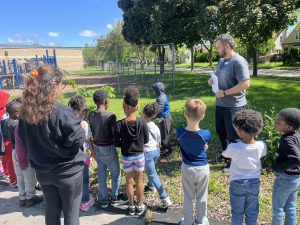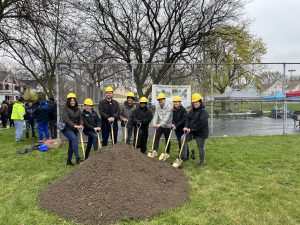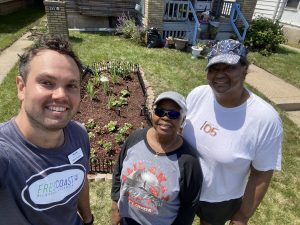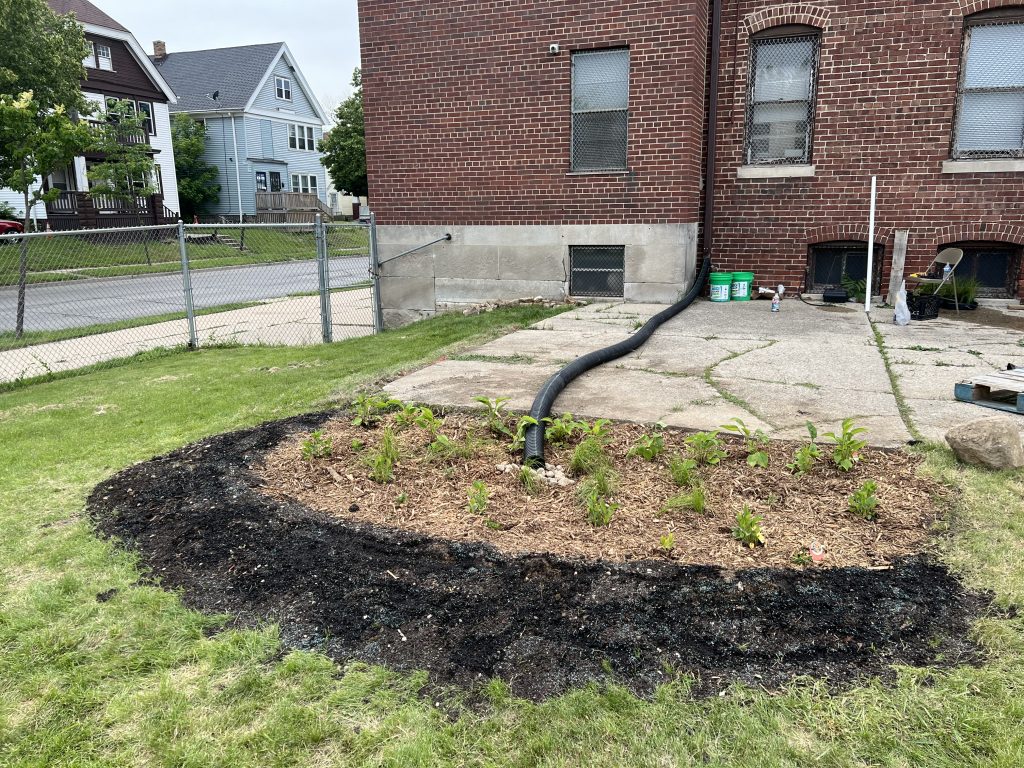On average, the City of Milwaukee sees about 2-4 inches of rainfall each month, with instances of more frequent and heavier rains as the climate continues to change. While 2–4 inches of rainfall may not sound like a lot, it can cause major problems when city infrastructure is largely impervious, resulting in large amounts of runoff into our waterways, basement sewage backups, and millions in property damage for homeowners. The historic floods of 2008 and 2010 left many neighborhoods without power; sinkholes in the street halted movement, and debris from destroyed properties littered the neighborhoods. If these rain events continue with the same intensity, we are looking at a future of more polluted waterways, damaged homes and dangerous health conditions. What can we do to secure a future for ourselves and our environment that is healthy, sustainable, and enjoyable? There is a solution, and you’ve likely interacted with it before—green infrastructure.
The Clean Wisconsin green infrastructure initiative, part of a contract with the Milwaukee Metropolitan Sewerage District that started in 2014, supports Milwaukee residents in the 30th Street Corridor by implementing neighborhood driven solutions to stormwater challenges. Through partnerships, training, and community-led installations of rain gardens, rain barrels, and other green infrastructure, the program helps address flooding, improve water quality, and expand green space. Rooted in local knowledge and collaboration, the program strengthens ongoing efforts to build climate resilience and environmental justice in historically underserved areas, with measurable impact and continued momentum heading into the 2025 season.
What is green infrastructure?

Green infrastructure is a stormwater management practice that supports the absorption of stormwater and runoff by mimicking natural systems by using native plants and soil filtration or capturing stormwater for reuse. Some common practices you may have seen around your neighborhood include rain barrels, rain gardens, and bioswales in the street median or along the curb. Private property and parking lots account for 59% of the impervious surfaces in the region, so at-home green infrastructure absolutely makes a difference. Each rain barrel we install can hold 50 gallons of storm water! In a 1-inch rainstorm, these barrels fill within 30 minutes of rain fall, providing a little insight into just how much water is falling. Rain gardens are another common tool and can capture 7-gallons of water for every square foot. In addition to their efficacy, rain gardens offer an aesthetic upgrade to your property and a new way to stay connected with the land you live on.
A Decade of Community-Led Green Infrastructure
Clean Wisconsin’s green infrastructure initiative has passed a major milestone: over a decade of working alongside Milwaukee residents to manage stormwater in ways that are both sustainable and rooted in community priorities. Since 2014, the program has supported the installation of 905 rain barrels and 94 rain gardens, capturing an estimated 1,375,000 gallons of stormwater to date. Across the broader Milwaukee Metropolitan Sewerage District (MMSD) supported efforts, more than 27,500 rain barrels have been distributed citywide. This summer, the initiative is on track to celebrate two major milestones: the installation of its 1,000th rain barrel and 100th rain garden. These numbers are more than just metrics; they reflect years of sustained trust, participation, and collective action across Milwaukee neighborhoods.
Deepening and Expanding Community Partnerships
Partnerships are at the heart of the green infrastructure initiative’s success. Over the years, Clean Wisconsin has built meaningful relationships with community-based organizations that help guide and shape outreach and implementation. This includes ongoing collaboration with the Fresh Coast Intern Team (FCIT), a youth workforce development initiative focused on climate and water issues; the Sherman Park Community Association, which supports neighborhood resilience; and City of Milwaukee ECO Neighborhood leaders in Harambee, who are advancing grassroots environmental projects. The initiative also provides training and support for the Greening Congregations Initiative, helping equip volunteers with knowledge to incorporate green infrastructure practices at places of worship.
This summer, outreach expanded further into the Harambee neighborhood, where the program hosted its first-ever rain barrel workshop in collaboration with Milwaukee Metropolitan Sewerage District, Sherman Park Community Association, and the Harambee ECO volunteer team. The event drew about 40 residents, many of whom took home rain barrels the same day. This turnout not only demonstrated strong interest in green infrastructure but also highlighted the importance of tailoring outreach methods to each neighborhood’s communication styles and needs.
Momentum in 2025: What’s New This Season
The 2025 season is already underway, rain barrel installations began on May 30 and rain garden installations began on June 6. This year, the program aims to install at least 20 rain gardens, expanding its physical footprint while deepening its engagement in neighborhoods along Milwaukee’s north and northwest sides. The program continues to work closely with the Fresh Coast Intern Team, who support installations while gaining hands-on training in green infrastructure design, maintenance, and community outreach.

New events this season include a tree workshop held on June 5 in partnership with Milwaukee Urban Forestry, which provided guidance on the best tree species for Milwaukee yards and tips for long-term tree care, an important part of resilient landscaping. On June 7, the team also hosted a stormwater modeling event at the Dominican Center in Amani, helping residents better understand how water moves through their neighborhood and how green infrastructure can make a difference. These events are designed not just to inform but to connect science with lived experience, empowering residents to be part of the solutions in their communities.
Creative, Public-Facing Projects
This summer, the green infrastructure program is also expanding its presence in public spaces through creative collaborations. At Melvina Park, a major green infrastructure site, the team is partnering with Quad Graphics to recycle and repurpose old rain barrels, transforming them into art pieces painted by ArtWorks. These barrels will be installed in visible community spaces and will serve as both functional stormwater tools and visual storytelling devices, inviting conversation, sparking curiosity, and celebrating local creativity. This initiative reflects the program’s growing emphasis on connecting green infrastructure with public art, youth engagement, and community identity.

Looking Ahead
As the 2025 season progresses, the green infrastructure initiative is focused on scaling up its impact while deepening its roots. In addition to reaching key milestones in rain barrel and garden installations, the program continues to nurture long-term partnerships, support local leadership, and invest in community-driven resilience planning. With new collaborations in Harambee, ongoing engagement in Sherman Park and Amani, and an ever-growing network of active residents, the program is helping shape a Milwaukee where flood prevention, environmental justice, and neighborhood pride go hand in hand. Looking ahead, the focus remains on listening, learning, and continuing to co-create solutions with the communities who know their neighborhoods best.

